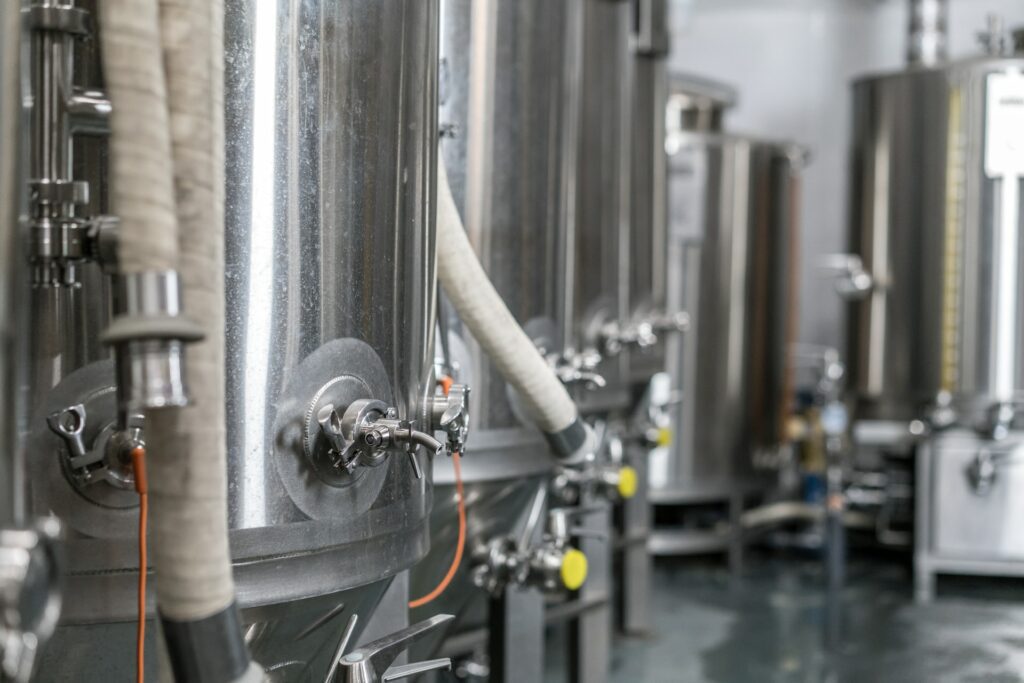03/13/2023 | Food & Beverage | 9 MINUTE READ
Why pH Meters are a Brewer’s Best Friend

The process of brewing beer is complex and requires the management of many moving parts. While numerous aspects of the brewing process must be monitored to ensure that the final look and taste match the brewer’s preferences, among the most important factors that should be monitored is the pH. Maintaining the right pH in a stout beer ensures that it carries the proper flavor and goes through the correct amount of enzymatic activity.
The pH of beer determines how acidic the beverage is. Most beers are slightly acidic with a pH range that extends from 4.0-4.4. If the pH levels are too high, the flavors could be harsher than anticipated. It’s also possible that the enzymatic conversion of the mash is incomplete. While beer is being produced, measuring pH levels is essential during every facet of the brewing process. When water is first added to develop the mash, pH readings should be taken. The same is true with the finished beer.
The initial concept of pH was invented by S.P.L. Sorensen, a Danish chemist who performed pH experiments with beer in 1909. Known as the potential of hydrogen, pH can be used to measure the quality of water with a scale that ranges from 0-14. When the beer’s pH value is below 7.0, the beverage is considered acidic. Any number above 7.0 would make the beer alkaline. In this guide, you’ll discover why pH is essential in the production of stout beers.

pH and Brewing: Why It Matters
Brewing and pH are tied to one another, which is why all brewers should have a pH meter that allows them to continuously monitor pH levels during the beer manufacturing process. By paying careful attention to the pH level of your beer, you could improve protein coagulation and extraction amounts. It’s also possible to regulate the taste and appearance of beer by maintaining the right pH levels.
While some brewers consider temperature to be the most critical aspect of maintaining beer quality, commercial brewers and advanced home brewers typically believe that pH is just as important. During a brew session, pH measurement allows you to make sure that everything’s on track. You’ll also be able to detect major issues immediately after they occur if the meter provides you with highly variable pH readings.
When creating stout beers, the process of monitoring pH levels begins with the mash, which represents the first stage of the brewing process. At this stage, water is mixed with crushed grains to create a mash-like texture. Regardless of the type of beer that’s being brewed, the pH readings for the mash will be the same. The optimal readings range from 5.2-5.6 when the water is mixed with the grains. However, the highest-quality mash occurs at around 5.2-5.3.
Obtaining the correct pH at this stage of the process is necessary to ensure that the wort properly converts into beer in the latter stages. There are times, however, when the pH values may be less than ideal. In this situation, the pH can be successfully altered during the mash process.

The Mystery of Stout Beer: Definition and Characteristics
Stout beer comes from the “porter” beer that was first developed in London during the 1720s. This beer was popular with the working class and would soon become the primary beverage of choice throughout London. The earliest porters were strong beers that consisted of around 6.5% alcohol concentration, which allowed the freshness of the beverage to be maintained over a lengthy period of time.
Dozens of different breweries created porters that had different characteristics and styles. One such brew was referred to as a “single stout” and was known to have a dark appearance as well as a strong and roasty taste. Since that time, porters have continued to evolve.
The strong and robust dark beer was created with an inexpensive brown malt that was produced with inconsistent roasting processes. In the decades to follow, the popularity of porter beers rose rapidly. Once the beer got to Ireland in 1776, Guinness began creating their own styles.
In the early 19th century, Guinness was able to use black patent malt, which provided stout beers with a less sweet and more roasted taste when compared to the taste produced when using brown barley.
Today, porters and stouts are slightly different versions of malty dark ales that have a similar history but different characteristics. While porters have the same dark brown color, they don’t have the burnt roasted taste that the barley does when used in darker stouts. Stout is a dark, creamy, roasty, and bitter ale. In comparison, porter is a malty and dark ale that can have several different flavor profiles.

Measuring pH in Stout Brewing
A pH meter is a type of instrument that’s used to measure a solution’s alkalinity or salinity. As touched upon previously, it uses a scale that ranges from 0-14. The data provided by the pH meter allows you to understand the activity of a base or acid when it comes to hydrogen ion activity.
The solution’s pH is related to the overall ratio of the hydroxyl ion and hydrogen ion that are present in the solution. When there’s more of the hydrogen ion in the solution when compared to the hydroxyl ion, the substance will be acidic, which means that the readings will be lower than 7.0. When the hydroxyl ion concentration is higher than the hydrogen ion concentration, the substance is alkaline. A neutral pH can be reached when there are equal amounts of the hydrogen and hydroxyl ions in the water.
When you want to use a pH meter in the brewing process, make sure that you connect the electrode and temperature probe directly to the instrument’s probe inset. From here, remove the electrode’s cap, after which you can turn the meter on. The temperature probe and pH electrode should then be immersed in the solution for testing. Once you’ve gently stirred the solution, you should wait for the reading to effectively stabilize.
After you remove the pH meter from the beer or water/crushed grains mixture, you should turn it off and rinse the electrode. The electrode’s protective cap should then be replaced. The reason why pH meters are essential in stout brewing is because they allow you to maintain the beer’s flavor profile and make sure that the wort is properly converted into beer. If you don’t detect pH variances when they occur, the final product may be disappointing.
pH Control in Stout Brewing
There are numerous biochemical and chemical reactions that occur during the production of beer. Most of these reactions are sensitive to the solution’s pH. For instance, protein coagulation during the boil is influenced by pH. Many of these brewing reactions involve proteins (enzymes) that are used as catalysts, which means that they aren’t directly consumed during the reaction. Instead, they have a significant effect on how quickly the reaction takes place. Enzymes catalyze reactions properly when within specific pH and temperature ranges.
The only reason why not every brewery uses pH meters is because of the presence of natural buffers in beer. These buffers make it difficult for the pH level to go too far outside of the optimal range. It’s only when something in the process goes wrong that pH readings can help you determine what the problem is and how it can be corrected. For instance, poor extraction efficiency can result in pH readings being far outside of the optimal range. The brewer can use these measurements to add acid to reduce the pH or calcium carbonate to increase it to the correct range. The pH of beer can affect:
- Hop oil extraction
- Beer foam stability
- The hop bitterness
- The beer’s appearance
If the pH levels aren’t in the 4.0-4.4 range, the taste could worsen considerably. Lower pH levels can also increase the amount of bacterial growth that occurs.

Decoding the pH of Stout Beer: Acidic or Basic?
The beer’s pH determines if it’s alkaline or acidic. Most beverages and food have a relatively neutral pH of 7.0. In comparison, beers can have pH levels that are as low as 3.0. When you measure the beer, you can detect the concentration of the hydrogen ion. As mentioned previously, a high concentration means that the beer is more acidic. All beers should be at least slightly acidic.
The traditional pH value for beer is 4.0. There are numerous factors that can influence the pH of stout beer. If the mash process didn’t go according to plan, the pH levels for the mash might be lower or higher than intended, which would worsen the pH for the rest of the process. Any issue that occurs throughout any stage of the process could cause substantial changes to the beer’s pH. The ideal pH levels for different types of beers include:
- Sour beer – 3.0
- Porter – 3.5-5.5
- Stout – 4.0-4.4
- Ale – 4.0-4.5
- Wheat beer – 4.1-4.5
- Lager – 4.3-4.6
- Brown ale – 5.2-5.6
- Pale ale – 5.3-5.4
Achieving Optimal pH Levels in Stout Brewing
Since beer is meant to be slightly acidic, pH control is practically essential during the brewing process. If pH levels aren’t controlled, it’s possible that the beer would become alkaline, which would result in a bad taste and appearance. There are several techniques that can be used to control the pH levels in beer. The technique you use depends on the beer’s current pH. If the pH levels are too high, you can lower them by:
- Adding around two teaspoons of calcium chloride or calcium sulfate to every five gallons of beer
- Reducing the total number of carbonates by boiling water and allowing the water to precipitate
- Placing phosphoric acid or lactic acid into the solution
- Adding distilled water
You can increase the beer’s pH levels by adding a calcium carbonate buffer or a sodium bicarbonate buffer. An example of a calcium carbonate buffer is soda ash. Baking soda can be used as a sodium bicarbonate buffer.
Stout beers require precise pH levels to deliver the roasted taste that’s expected from this beer. If the pH levels are too high or too low, the beer won’t taste like a stout and might have an odd appearance. By using a pH meter to obtain readings at every stage of the process, you can maintain the proper pH levels in your beer with ease.
Posted by Dominic O'Donnell on March 13, 2023
Sensorex is a global leader in the design and manufacture of quality sensors for water quality and process applications. The company offers more than 2000 sensor packages for pH, ORP, conductivity, dissolved oxygen, free chlorine, chlorine dioxide, UV transmittance and other specialty measurements, as well as a full line of sensor accessories and transmitters. Its expert technical support engineers solve analytical sensor challenges with custom designs and off the shelf products.




